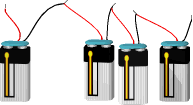Discussion
Home ‣ Electronics ‣ Operational Amplifiers See What Others Are Saying!
- Question
The common-mode voltage gain is
Options- A. smaller than differential voltage gain
- B. equal to voltage gain
- C. greater than differential voltage gain
- D. None of the above
- Correct Answer
- smaller than differential voltage gain
- 1. In a repetitive-pulse RC integrator circuit, what would the steady-state voltage equal at the end of the fifth pulse? Assume a Vin of 20 V.
Options- A. 1.46 V
- B. 14.62 V
- C. 20 V
- D. 0 V Discuss
- 2. In a series circuit, larger resistances drop larger voltages.
Options- A. True
- B. False Discuss
- 3.

If four 9 V batteries are connected series-aiding, the total voltage is 36 V.
Options- A. True
- B. False Discuss
- 4. What is the magnitude of the phase angle between the source voltage and current when a 100 mH inductor with an inductive reactance of 6 kΩ and a 1 kΩ resistor are in series with a source?
Options- A. 0.1°
- B. 9.0°
- C. 61.0°
- D. 81.0° Discuss
- 5. What is the true power of a 24 Vac parallel RL circuit when R = 45 Ω and XL = 1100 Ω?
Options- A. 313.45 W
- B. 12.8 W
- C. 44.96 W
- D. 22.3 W Discuss
- 6. A damaged resistor
Options- A. may appear burned
- B. may have an increased resistance value
- C. may be checked with an ohmmeter
- D. All of the above Discuss
- 7. Ohm's law is a relationship between
Options- A. voltage, current, and time
- B. power, current, and resistance
- C. resistance, time, and current
- D. voltage, current, and resistance Discuss
- 8. What three subcircuits does a phase locked loop (PLL) consist of?
Options- A. phase comparator, comparator, and VCO
- B. phase comparator, bandpass filter, and VCO
- C. phase comparator, bandpass filter, and demodulator
- D. phase comparator, low-pass filter, and VCO Discuss
- 9. A noninverting closed-loop op-amp circuit generally has a gain factor:
Options- A. less than one
- B. greater than one
- C. of zero
- D. equal to one Discuss
- 10. What is the average voltage when a rectangular wave's base line voltage is 20 V, its peak-to-peak voltage is 50 V, and its duty cycle is 20%?
Options- A. 26 V
- B. 30 V
- C. 40 V
- D. 45 V Discuss
More questions
Correct Answer: 14.62 V
Correct Answer: True
Correct Answer: True
Correct Answer: 81.0°
Correct Answer: 12.8 W
Correct Answer: All of the above
Correct Answer: voltage, current, and resistance
Correct Answer: phase comparator, low-pass filter, and VCO
Correct Answer: greater than one
Correct Answer: 30 V
Comments
There are no comments.More in Electronics:
Programming
Copyright ©CuriousTab. All rights reserved.
